Medical Disclaimer: This article is for informational purposes only and does not substitute professional veterinary advice. Always consult your veterinarian regarding your pet’s health.
Table of Contents
Introduction
If you’ve ever recoiled from a slobbery kiss because of dog bad breath, you’re not alone. As a small-animal vet in Ottawa, I’ve seen countless loving pet parents baffled by their dog’s foul-smelling mouth. It’s more than just an annoyance — persistent bad breath in dogs often signals something deeper, from dental disease to serious organ problems.
In my practice, I once examined a sweet older Cocker Spaniel named Daisy who came in for what her owner thought was “just bad breath.” A quick oral exam revealed advanced periodontal disease and a painful abscessed molar. After a dental cleaning and extraction, Daisy’s demeanor — and breath — transformed. That experience reminded me how vital it is not to ignore stinky breath.
This guide covers everything you need to know about dog bad breath: what causes it, how to treat it, when to worry, and what you can do at home to keep your pup’s mouth fresh and healthy.
Key Takeaways
- Dog bad breath is not normal — it’s often the first sign of dental disease or internal health issues.
- The most common cause is periodontal disease, but kidney failure, diabetes, and oral tumors can also cause foul breath.
- Home care like brushing, dental chews, and proper diet helps, but persistent or worsening symptoms should be seen by a vet.
- Early diagnosis and treatment of dog bad breath can prevent pain, tooth loss, and serious complications like heart or kidney disease.
- Prevention is key: daily dental care, annual vet check-ups, and safe diet habits can protect your dog’s oral and overall health.
What Causes Bad Breath in Dogs?
Also visit: https://doglifeexpert.com/essential-vets-guide-11-dog-skin-conditions/
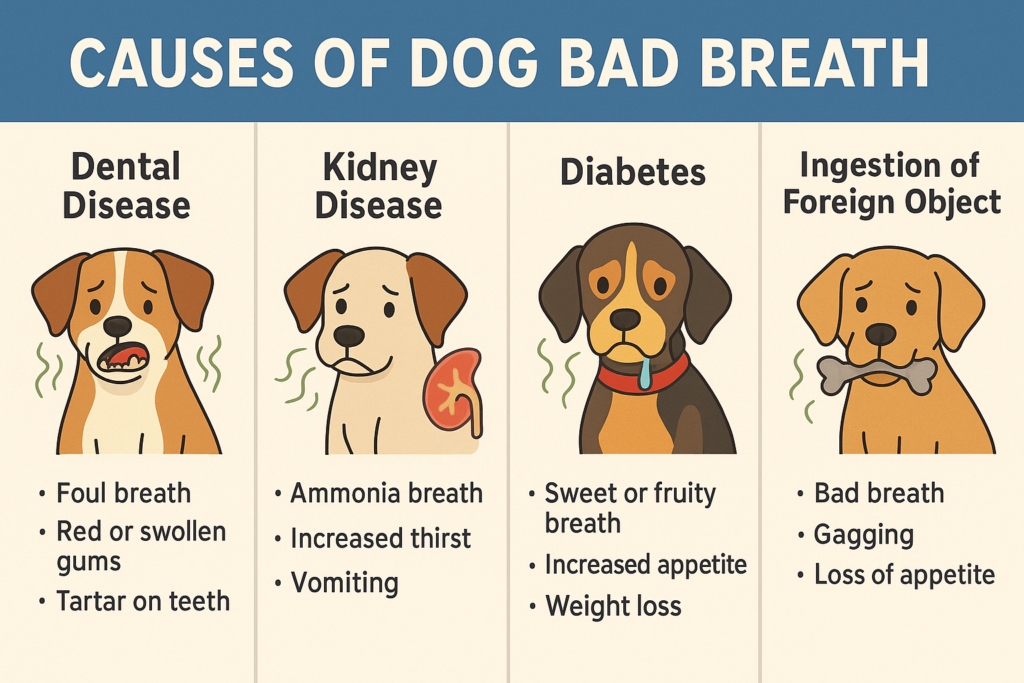
The term dog bad breath may sound harmless, but it can stem from a variety of health issues — some mild, others more serious. As a veterinarian, I always start with a thorough oral and physical exam to determine the root cause. Let’s break down the most common culprits.
Dental and Gum Disease
By far, the leading cause of dog bad breath is periodontal disease. It begins with plaque buildup and escalates into tartar, gum inflammation (gingivitis), and even bone loss (periodontitis).
Common signs include:
- Persistent foul odor
- Red, swollen gums
- Brownish tartar
- Bleeding when chewing
- Loose or missing teeth
I often see small breeds like Yorkies and Shih Tzus with advanced dental disease by age 5. Their crowded teeth create the perfect hiding spots for bacteria.
Sources: PetMD, VCA Animal Hospitals
Foreign Objects in the Mouth
Sometimes dog bad breath is caused by something as simple as a stick, toy fragment, or string stuck between the teeth or lodged in the gums.
Watch for:
- Bad breath and gagging
- Difficulty eating
- Pawing at the mouth
- Localized swelling or drooling
These cases often require sedation to safely remove the object and treat any infection or damage.
Systemic Conditions
Bad breath can reflect what’s happening inside the body. Systemic diseases can alter your dog’s metabolism and mouth chemistry, leading to unusual and unpleasant odors.
Kidney Disease
Dogs with kidney issues often develop dog bad breath that smells like ammonia or urine. This is due to uremic toxins building up in the blood.
Other signs:
- Increased thirst and urination
- Vomiting
- Weight loss
- Mouth ulcers
Liver Disease
Liver problems can cause a musty or rotten smell. You may also notice yellowing of the eyes or gums (jaundice), vomiting, and lethargy.
Diabetes
Uncontrolled diabetes can cause a sweet or fruity-smelling dog bad breath due to ketones in the bloodstream.
Signs include:
- Increased thirst
- Frequent urination
- Weight loss
- Lethargy
These conditions are serious and need veterinary attention for bloodwork and proper treatment.
Ingestion of Toxins or Feces
Dogs are curious creatures, and unfortunately, some like to eat things they shouldn’t.
Common sources:
- Cigarette butts (nicotine smell)
- Garbage
- Feces (coprophagia)
- Certain toxic plants
These often lead to dog bad breath described as rancid, metallic, or just downright offensive. Behavior training and environmental control are key.
Oral Tumors
Tumors in the mouth — especially in older dogs — can cause tissue decay and bacterial infection, resulting in a foul, rotten meat smell. I’ve diagnosed cases like this where owners were shocked to find a hidden lump causing their dog’s bad breath.
Poor Diet and Digestive Imbalance
Feeding an unbalanced or raw diet can alter your dog’s oral microbiome. Harmful bacteria like Salmonella may thrive, worsening dog bad breath and even putting humans at risk.
Red flags include:
- Dull coat
- Lethargy
- Intermittent vomiting or diarrhea
How to Diagnose the Cause of Dog Bad Breath
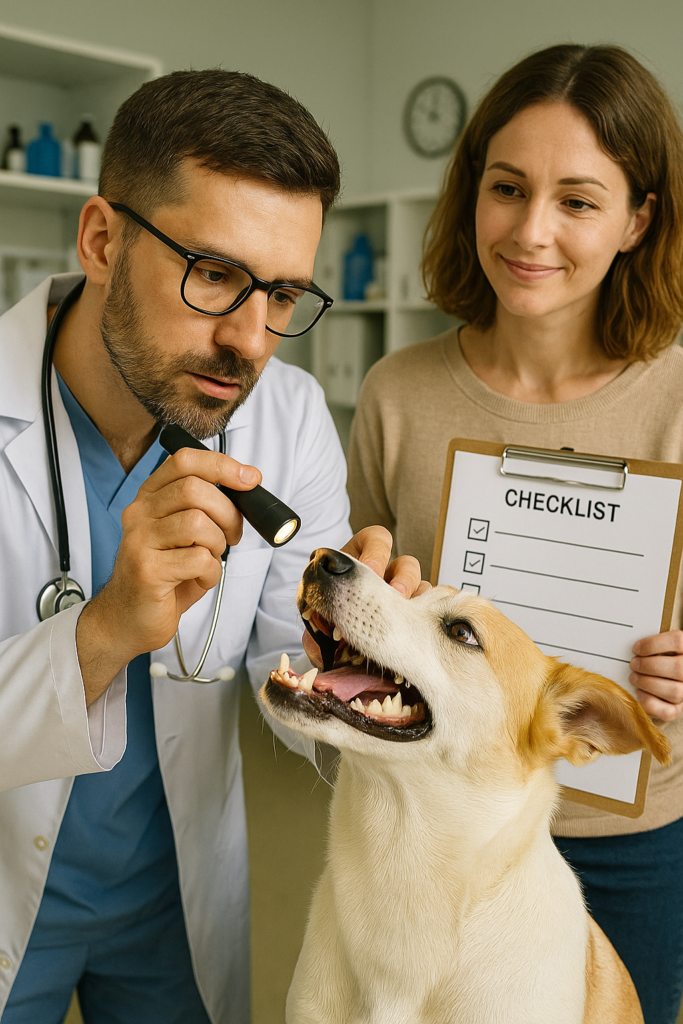
If your pup’s kisses come with a side of stink, the first step is figuring out why. Diagnosing dog bad breath isn’t just about smelling your dog’s mouth — it’s about spotting patterns and getting professional input when needed.
At-Home Symptom Checklist
Here’s a simple 5-minute checklist to help you assess whether your dog’s bad breath is a minor hygiene issue or a sign of something more serious:
| What to Check | What It Could Mean |
|---|---|
| Foul odor + red/swollen gums | Likely dental or gum disease |
| Breath smells like urine/ammonia | Kidney disease |
| Sweet/fruity smell | Diabetes |
| Musty/rotten odor + jaundice | Liver disease |
| Fecal or garbage odor | Coprophagia or eating trash |
| Rotten meat smell + growths | Possible oral tumor |
| No visible signs, just bad smell | Hidden foreign object or early gum disease |
Also, observe:
- Changes in appetite
- Weight loss
- Vomiting
- Excessive drinking or urination
- Lethargy or behavior changes
These symptoms, especially if they accompany dog bad breath, could signal a systemic condition.
When to See the Vet
If your dog shows any of the above warning signs or if the bad breath:
- Persists for more than a week
- Gets worse despite brushing or dental treats
- Comes with bleeding gums or visible lumps
…it’s time to book a vet appointment.
At the clinic, I usually perform:
- Oral exam (may need sedation for full view)
- Bloodwork (to check kidneys, liver, blood sugar)
- Dental X-rays (to detect bone loss or hidden abscesses)
- Urine tests (especially for diabetes or kidney disease)
Early veterinary diagnosis can prevent costly complications and improve your dog’s quality of life significantly.
Treatment Options for Bad Breath in Dogs
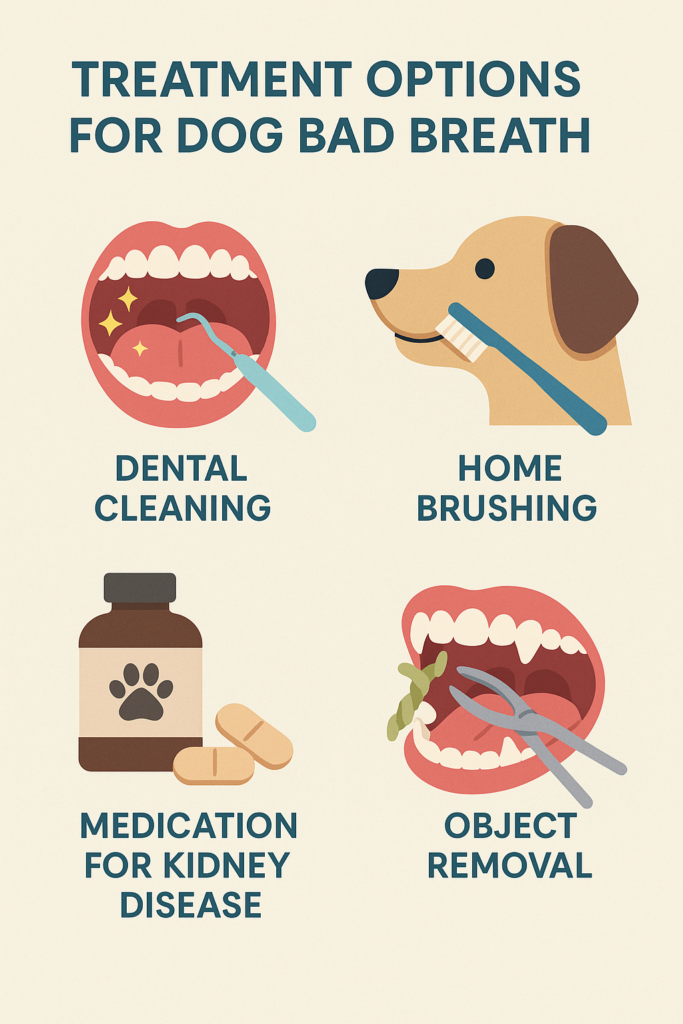
Treating dog bad breath effectively means addressing the root cause — whether that’s a mouth full of tartar, a stuck toy, or an underlying illness. Here’s how veterinarians like myself typically approach treatment, along with what you can do at home.
Veterinary Dental Cleaning
For most cases of dental disease, a professional dental cleaning under general anesthesia is the gold standard. This includes:
- Scaling off tartar and plaque (above and below the gumline)
- Polishing the teeth
- Dental X-rays to check for hidden issues
- Tooth extractions if necessary
I’ve treated many dogs who went from chronic halitosis and discomfort to happy, playful pups within days of their cleaning.
Typical Canadian cost:
| Procedure | Estimated Cost (CAD) |
|---|---|
| Basic cleaning | $400–$700 |
| Cleaning + extractions | $800–$1500+ |
| Dental X-rays (add-on) | $150–$300 |
Pet insurance may help cover these costs depending on the plan.
Home Dental Care Products
Post-cleaning — or as prevention — at-home dental care is essential for managing dog bad breath.
Effective tools include:
- Dog-safe toothpaste & toothbrush
(Never use human toothpaste. Brands like Virbac C.E.T. Enzymatic are vet-approved.) - Dental chews
Look for VOHC-approved products like Greenies or OraVet Chews. - Water additives
Products like PetLab Co. Dental Formula reduce bacteria with each drink. - Dental powders and sticks
For dogs who resist brushing, dental powders or probiotic sticks like PetLab Co. Dental Powder can help freshen breath.
Managing Systemic Diseases
If dog bad breath is due to a systemic illness, treatment must target the root condition:
- Kidney disease → Low-protein renal diets, IV fluids, medications
- Liver disease → Liver-support diets, supplements like SAMe or milk thistle
- Diabetes → Insulin therapy, strict diet, daily blood sugar monitoring
Vets may refer you to internal medicine specialists for complex cases.
Removing Foreign Bodies or Tumors
- Stuck objects like sticks or bones are removed under sedation or anesthesia.
- Oral tumors may require biopsy, surgical removal, or cancer treatment.
In one case, a client’s Lab had persistent dog bad breath that wouldn’t resolve. An X-ray revealed a plastic toy fragment embedded behind a molar. After removal, his appetite — and breath — bounced back immediately.
Preventing Dog Bad Breat
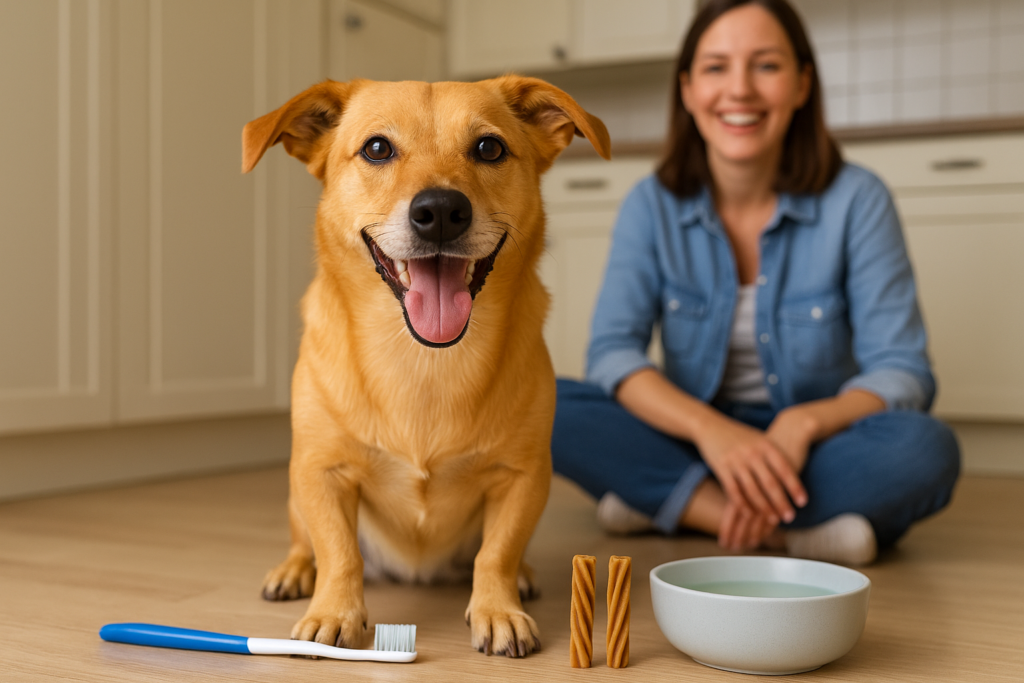
The best way to fight dog bad breath is to prevent it in the first place. Establishing a daily oral hygiene routine and making a few smart choices can save you and your dog a lot of discomfort — and costly vet bills — down the road.
Daily Dental Hygiene
Nothing beats brushing when it comes to preventing plaque and dog bad breath.
Brushing tips:
- Use a soft-bristled toothbrush and dog-specific toothpaste
- Start slow: let your dog lick the toothpaste first
- Brush along the gumline in small circles for 2–3 minutes
- Reward with a treat or praise
Aim to brush daily or at least 3–4 times per week. Dental wipes or finger brushes can be alternatives for reluctant pups.
Dental Chews and Toys
Some dogs hate toothbrushes. In these cases, dental chews or textured toys can help reduce plaque mechanically.
Recommended options:
Always supervise chewing to prevent choking, especially with aggressive chewers.
Balanced Diet
Nutrition impacts oral health more than most realize. Poor-quality or unbalanced diets can promote bacterial overgrowth and worsen dog bad breath.
Tips:
- Choose a complete, balanced commercial dog food
- Avoid raw or home-cooked diets unless guided by a veterinary nutritionist
- Limit sugary treats and table scraps
- Consider dental diets like Hill’s t/d or Royal Canin Dental
5-Minute Home Checklist
Quick weekly checks can help you catch problems before they worsen:
| Check | What to Look For |
|---|---|
| Mouth/gums | Redness, swelling, tartar, bleeding |
| Teeth | Discoloration, fractures, loose teeth |
| Breath | New or worsening foul odors |
| Eating habits | Difficulty chewing, dropping food |
| Behavior | Pawing at mouth, irritability, hiding |
If anything seems off, schedule a vet visit.
Regular Veterinary Visits
Even the most diligent home care can’t replace professional dental exams. I recommend:
- Annual dental checkups for most dogs
- Biannual exams for small breeds or those with dental history
- Early senior screening (age 7+) to catch systemic causes of dog bad breath
Environmental Safety
To prevent ingestion-related dog bad breath:
- Keep trash bins secure
- Supervise dogs outside (watch for feces or dead animals)
- Avoid access to toxic plants or chemicals
- Store chew toys safely to avoid splinters or breakage
When to Worry: Red Flags for Immediate Vet Care
Not all dog bad breath is created equal. Sometimes it’s just leftover kibble odor. Other times, it’s a warning sign that something serious is going on. Here’s how to tell the difference.
Warning Signs That Need Immediate Attention
Call your vet if you notice:
- Sudden, severe, or persistent bad breath that doesn’t improve with brushing or chews
- Ammonia- or urine-like odor (possible kidney disease)
- Sweet/fruity breath (could indicate diabetic ketoacidosis)
- Rotten meat smell despite clean teeth (possible oral tumor or dead tissue)
- Visible oral growths, bleeding, or sores
- Loss of appetite, vomiting, or weight loss
- Drinking or urinating excessively
- Lethargy or hiding behavior
A Personal Case from Practice
One of my patients, a 9-year-old Boxer named Luna, came in with increasingly bad breath. Her teeth looked decent, but the smell was putrid — like rotting meat. X-rays revealed an oral tumor hidden beneath the gumline. Early detection allowed her to receive surgery and improve her quality of life dramatically.
If your dog’s breath changes suddenly or smells “off,” don’t wait. Your dog can’t tell you what’s wrong — but their breath might.
FAQs About Dog Bad Breath
1. What does bad breath in dogs usually mean?
In most cases, dog bad breath means dental disease — specifically plaque and tartar buildup leading to gum infection. However, it can also signal internal issues like kidney disease, diabetes, or liver problems, especially if the odor is unusually strong or sweet.
2. How often should I brush my dog’s teeth?
Daily is ideal, but brushing at least 3–4 times per week significantly reduces the risk of bad breath and dental disease. Use only dog-specific toothpaste and a soft toothbrush.
3. Can dog breath fresheners replace brushing?
No. While water additives, dental chews, and powders can help reduce odor, they don’t fully remove plaque or prevent gum disease. Brushing is the gold standard for preventing dog bad breath.
4. Is bad breath in puppies normal?
Mild odor can occur during teething, but persistent or foul-smelling breath isn’t normal. Puppies can also suffer from early dental problems or ingest foreign objects. Always check with your vet if in doubt.
5. Do small dogs get bad breath more often?
Yes, absolutely. Small and flat-faced breeds (like Chihuahuas, Pugs, and Yorkies) often have crowded teeth, which trap bacteria and food debris — a major cause of dog bad breath. They also tend to live longer, increasing their risk of dental issues over time.
6. Does human food cause bad breath in dogs?
Yes. Sugary or fatty human foods disrupt oral bacteria balance and can worsen bad breath. Bones and leftover scraps can also splinter or get stuck, causing infections or gum injury.
Why Oral Health Matters for Your Dog’s Whole Body
Freshening your dog’s breath is only one part of the puzzle. Chronic dog bad breath can be a sign of underlying health issues that go far beyond the mouth.
How Oral Health Affects the Body
When gum disease is left untreated, bacteria from the mouth can enter the bloodstream — a process known as bacteremia. These bacteria can then travel and impact major organs, leading to:
- Heart disease (endocarditis)
- Kidney inflammation
- Liver infections
- Joint issues
One study from Central Broward Animal Hospital highlighted a significant link between severe periodontal disease and heart disease in dogs. I’ve seen this firsthand — older dogs with bad teeth who developed heart murmurs or signs of systemic inflammation.
Signs It’s Affecting More Than Just the Mouth
- Increased tiredness or lethargy
- Difficulty recovering from illness
- Chronic infections
- Weight loss despite normal appetite
That’s why taking care of your dog’s teeth isn’t just cosmetic — it’s vital healthcare. Regular dental cleanings and home care routines can help extend your dog’s life and improve their comfort daily.
Final Thoughts & Vet’s Advice
Dog bad breath is more than just an inconvenience — it’s often your first clue that something’s wrong inside your dog’s mouth or body. Whether it’s caused by tartar buildup, systemic illness, or dietary issues, foul breath should never be ignored.
Here’s my advice as a veterinarian:
- Don’t normalize stinky breath. It’s usually a symptom, not just a smell.
- Brush your dog’s teeth regularly. Even a few times a week makes a big difference.
- Use VOHC-approved chews and additives to support oral hygiene.
- Watch for behavior changes. If your dog is eating less, hiding, or pawing at their mouth, something deeper may be going on.
- Schedule annual dental checkups. Prevention is cheaper and safer than treatment.
Every time I help a dog recover from severe dog bad breath — like Daisy the Cocker Spaniel or Luna the Boxer — their owners say the same thing: “She seems like herself again.” Fresh breath often goes hand-in-hand with restored comfort, energy, and quality of life.

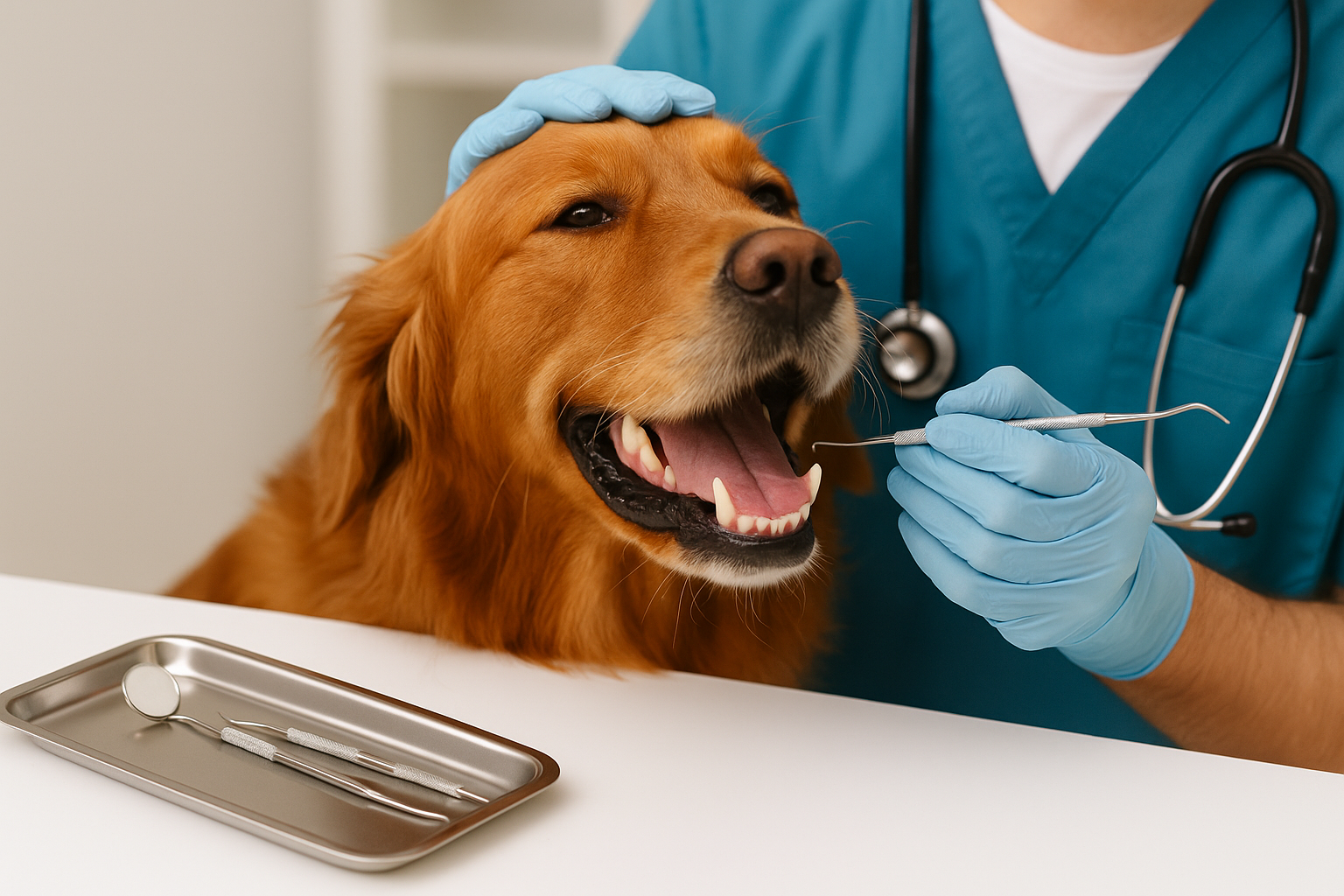
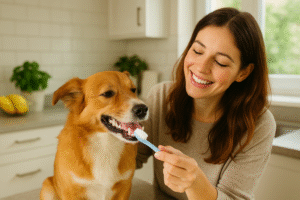

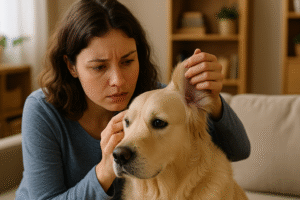
Pingback: Top 10 Crucial Facts About Dog Ear Infections: Causes, Symptoms & Treatments